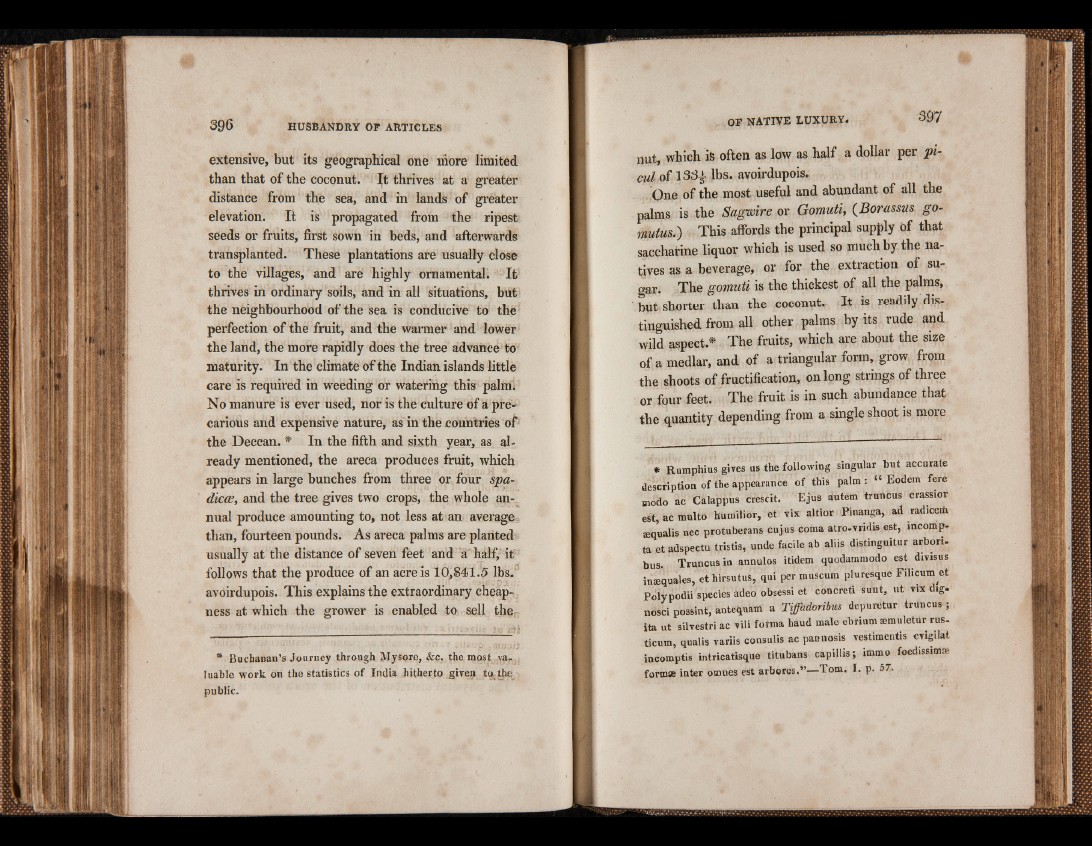
extensive, but its geographical one more limited
than that of the coconut. Jt thrives at a greater
distance from the sea, and in lands of greater
elevation. It is propagated from the ripest
seeds or fruits, first sown in beds, and afterwards
transplanted. These plantations are usually close
to the villages, and are highly ornamental. It
thrives in ordinary soils, and in all situations, but
the neighbourhood of the sea is conducive to the
perfection of the fruit, and the warmer and lower
the land, the more rapidly does the tree advance to
maturity. In the climate of the Indian islands little
care is required in weeding or watering this palm*
No manure is ever used, nor is the culture of a precarious
and expensive nature, as in the countries of
the Deccan. * In the fifth and sixth year, as already
mentioned, the areca produces fruit, which
appears in large bunches from three or four spa-
diccB, and the tree gives two crops, the whole annual
produce amounting to, not less at an average
than, fourteen pounds. As areca palms are planted
usually at the distance of seven feet and a half, it
follows that the produce of an acre is 10,841.5 lbs.
avoirdupois. This explains the extraordinary cheapness
at which the grower is enabled to self the
* Buchanan’s Journey through Mysore, &c. the most valuable
work on the statistics of India hitherto given to the
public.
nut, which is often as low as half a dollar per picul
of 133-t- lbs. avoirdupois.
One of the most useful and abundant of all the
palms is the Sagwire or Gomuti, (Borassus go-
mulus.') This affords the principal supply of that
saccharine liquor which is used so much by the natives
a s a beverage, or for the extraction of sugar.
The gomuti is the thickest of all the palms,
but shorter than the coconut. It is readily distinguished
from all other palms by its rude arid
wild aspect.* The fruits, which are about the size
of a medlar, and of a triangular form, grow from
the shoots of fructification, on long strings of three
or four feet. The fruit is in such abundance that
the quantity depending from a single shoot is more
* Rumphius gives us the following singular but accurate
description of the appearance of this palm: “ Eodem fere
modo ac Calappus crescit. Ejus autem truncus crassior
est, ac multo humiliör, et vix altior Pinanga, ad radicchi
sequalis nec protuberans cujus coma atro-vridis est, incoitip-
ta et adspectu tristis, unde facile ab aliis distinguitur arbori-
bus. Truncus in annulos itidem quodammodo est divisus
insequales, et hirsutuS, qui per museum pluresque Filicum et
Polypodii species adeo obsessi et concreti sunt, ut vix dig.
nosci possint, ante^uam a Tifadoribus depuretur truncus ;
ita ut silvestri ac vili fotma hàud male ebtium mmuletur rus-
ticum, qualis variis consulis ac paunosis vestimentis erigila!
incomptis intricatisque titubans capillis ; immo foedissimae
form* inter omnes est arbores.”—Tom. I. p. 57.